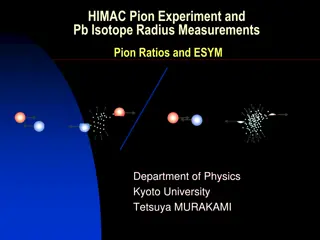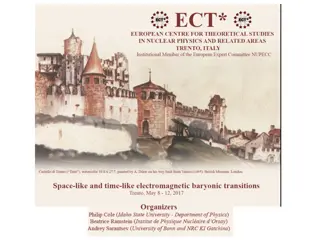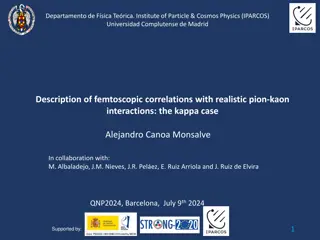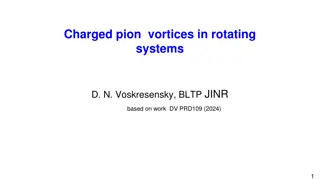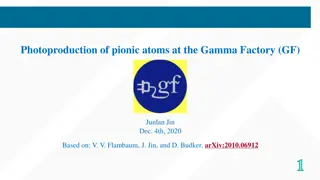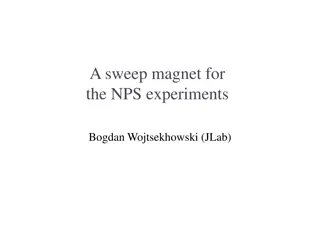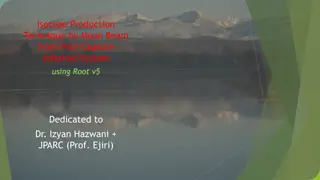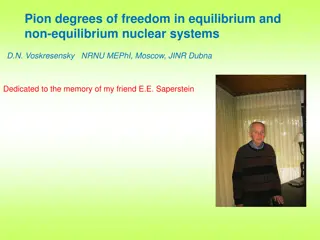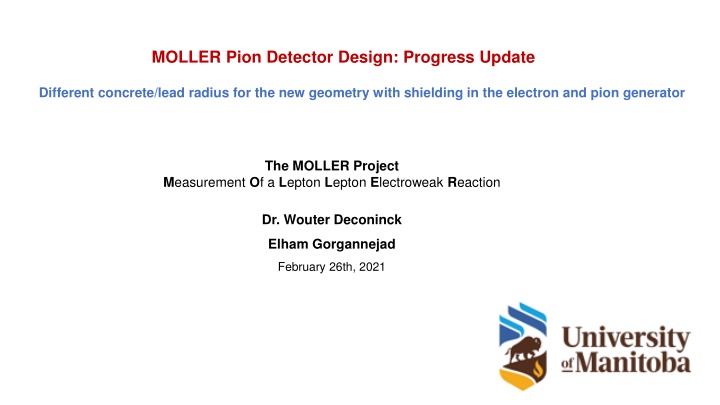
Progress Update on MOLLER Pion Detector Design and Shielding Geometry
This update discusses the progress made in designing the Pion detectors for the MOLLER Project, focusing on the varying concrete and lead radius configurations for improved shielding in the electron and pion generator. It includes details on the geometry of the Pion detectors and Lucite detectors, as well as the origin locations of secondaries in different concrete and lead setups for electron-pion interactions.
Download Presentation

Please find below an Image/Link to download the presentation.
The content on the website is provided AS IS for your information and personal use only. It may not be sold, licensed, or shared on other websites without obtaining consent from the author. If you encounter any issues during the download, it is possible that the publisher has removed the file from their server.
You are allowed to download the files provided on this website for personal or commercial use, subject to the condition that they are used lawfully. All files are the property of their respective owners.
The content on the website is provided AS IS for your information and personal use only. It may not be sold, licensed, or shared on other websites without obtaining consent from the author.
E N D
Presentation Transcript
MOLLER Pion Detector Design: Progress Update Different concrete/lead radius for the new geometry with shielding in the electron and pion generator The MOLLER Project Measurement Of a Lepton Lepton Electroweak Reaction Dr. Wouter Deconinck Elham Gorgannejad February 26th, 2021
Geometry of Pion detector PMT shielding radial thickness of Concrete and Lead Concrete/lead radius extend 16, 21, 26, 30, 35 cm keep concrete at 16 cm, extend lead only to 26 cm keep lead at 16 cm, extend concrete only to 26 cm fix downstream face of donut, then reduce lead thickness Concrete Lead donut (Pb absorber) 2
Geometry of Lucite detector pionDetectorLucitePMTDiameter = 2.54 cm pionDetectorLucitePMTHousingHeight = 7.5 cm pionDetectorLuciteLightGuideHeight = 20 cm pionDetectorLuciteReflectorDepth =2.54 cm pionDetectorLuciteReflectorWidth=40 cm pionDetectorLuciteHeight = 7cm pionDetectorLuciteReflectorHeight = 20 cm pionDetectorLuciteOutsideWidth = 45 cm pionDetectorLuciteWedgeHeight = 1.27 cm pionDetectorLuciteInsideWidth = 39 cm 3 pionDetectorLucitePlaneThickness = 2.54 cm
The origin location of all the secondaries anywhere for 5,000,000 events (16 cm concrete and upstream Lead ) Electron Pion hit.trid==1 12 hit.trid==2 10 hit.trid==1 142857 T->Draw("sqrt(hit.vx**2+hit.vy**2):hit.vz>>h1(100,23800,26000,100,600,2200)") 4
The origin location of all the secondaries anywhere for 5,000,000 events (21 cm concrete and upstream Lead ) Electron Pion hit.trid==1 78 hit.trid==2 82 hit.trid==1 146168 T->Draw("sqrt(hit.vx**2+hit.vy**2):hit.vz>>h1(100,23800,26000,100,600,2200)")
The origin location of all the secondaries anywhere for 5,000,000 events (26 cm concrete and upstream Lead ) Electron Pion hit.trid==1 1 hit.trid==2 0 hit.trid==1 150426 T->Draw("sqrt(hit.vx**2+hit.vy**2):hit.vz>>h1(100,23800,26000,100,600,2200)") 6
The origin location of all the secondaries anywhere for 5,000,000 events (30 cm concrete and upstream Lead ) Electron Pion hit.trid==1 1 hit.trid==2 1 hit.trid==1 145238 T->Draw("sqrt(hit.vx**2+hit.vy**2):hit.vz>>h1(100,23800,26000,100,600,2200)") 7
The origin location of all the secondaries anywhere for 5,000,000 events (35 cm concrete and upstream Lead ) Electron Pion hit.trid==1 0 hit.trid==2 0 hit.trid==1 147195 T->Draw("sqrt(hit.vx**2+hit.vy**2):hit.vz>>h1(100,23800,26000,100,600,2200)") 8
Comparison of rates at the Lucite for 5,000,000 events (Low energy particles, hit.p<2*MeV) Rates ?? /???????? Rate of photons from electrons Rate of photons from pions Rate of electrons Rate of pions Pi/e Pi/e ? ?? 0.48% 2.38% ?.?? ?.?? ?? ? ?.?? ?.?? ?? ? ?.??? ?.??? ?? ? ?.??? ?.??? ?? ? Concrete and Lead at 16cm 1.21% 5.50% ?.?? ?.?? ?? ? ?.?? ?.?? ?? ? ?.?? ?.?? ?? ? ?.??? ?.??? ?? ? Concrete and Lead at 21cm 2.62% 8.18% ?.?? ?.?? ?? ? ?.?? ?.?? ?? ? ?.?? ?.?? ?? ? ?.??? ?.??? ?? ? Concrete and Lead at 26cm 3.56% 11.19% ?.?? ?.?? ?? ? ?.?? ?.?? ?? ? ?.?? ?.?? ?? ? ?.??? ?.??? ?? ? Concrete and Lead at 30cm 4% 15.93% ?.?? ?.?? ?? ? ?.?? ?.?? ?? ? ?.?? ?.?? ?? ? ?.??? ?.??? ?? ? Concrete and Lead at 35cm T->Draw("1","(rate/5.95e13)*(hit.det==8001 && hit.p<2*MeV && (hit.pid==11 || hit.pid==-11 || hit.pid==211 || hit.pid==-211 || hit.pid==13 || hit.pid==- 13))") T->Draw("1","(rate/5.95e13)*(hit.det==8000)") Note: 5.95e13 comes from 85*14*10^9*50 to be in the unit of ?? ? ??/????????/simulation 9
Comparison of rates at the Lucite for 5,000,000 events (Low energy particles, hit.p<2*MeV) 14 7 6 12 Rate of electrons*(10^-4) 5 10 Rate of Pions*(10^-6) 4 8 3 6 2 4 1 2 0 0 0 5 10 15 20 25 30 35 40 0 5 10 15 20 25 30 35 40 Outer radial of the Lead (cm) concrete/lead radius (cm) 25 6 Rate of photons from electrons*(10^-3) Rate of photons from pions*(10^-4) 5 20 4 15 3 10 2 5 1 0 0 0 5 10 15 20 25 30 35 40 0 5 10 15 20 25 30 35 40 10 concrete/lead radius (cm) Outer radial of the Lead (cm)
Comparison of rates at the Lucite for 5,000,000 events (High energy particles, hit.p>2*MeV) Rates ?? /???????? Rate of photons from electrons Rate of photons from pions Rate of electrons Rate of pions Pi/e Pi/e ? ?? 12.05% 2.38% ?.?? ?.?? ?? ? ?.??? ?.??? ?? ? ?.??? ?.??? ?? ? ?.??? ?.??? ?? ? Concrete and Lead at 16cm 99.8% 5.50% ?.?? ?.?? ?? ? ?.??? ?.??? ?? ? ?.?? ?.?? ?? ? ?.??? ?.??? ?? ? Concrete and Lead at 21cm 261% 8.1% ?.??? ?.??? ?? ? ?.?? ?.?? ?? ? ?.??? ?.??? ?? ? ?.?? ?.?? ?? ? Concrete and Lead at 26cm 344% 11.19% ?.??? ?.??? ?? ? ?.?? ?.?? ?? ? ?.??? ?.??? ?? ? ?.?? ?.?? ?? ? Concrete and Lead at 30cm 424% 15.93% ?.??? ?.??? ?? ? ?.?? ?.?? ?? ? ?.??? ?.??? ?? ? ?.?? ?.?? ?? ? Concrete and Lead at 35cm T->Draw("1","(rate/5.95e13)*(hit.det==8001 && hit.p>2*MeV && (hit.pid==11 || hit.pid==-11 || hit.pid==211 || hit.pid==-211 || hit.pid==13 || hit.pid==- 13))") T->Draw("1","(rate/5.95e13)*(hit.det==8000)") Note: 5.95e13 comes from 85*14*10^9*50 to be in the unit of ?? ? ??/????????/simulation 11
Comparison of rates at the Lucite for 5,000,000 events (High energy particles, hit.p>2*MeV) 1.8 140 1.6 120 1.4 Rate of electrons*(10^-5) Rate of Pions*(10^-4) 100 1.2 1 80 0.8 60 0.6 40 0.4 0.2 20 0 0 0 5 10 15 20 25 30 35 40 0 5 10 15 20 25 30 35 40 concrete/lead radius (cm) concrete/lead radius (cm) 25 6 Rate of photons from electrons*(10^-3) Rate of photons from pions*(10^-4) 5 20 4 15 3 10 2 5 1 0 0 0 5 10 15 20 25 30 35 40 0 5 10 15 20 25 30 35 40 concrete/lead radius (cm) concrete/lead radius (cm) 12
Concrete and Lead at 16cm Concrete and Lead at 26cm Concrete and Lead at 21cm Concrete and Lead at 30 cm Concrete and Lead at 35cm 13 T->Draw("hit.x:hit.z >>h(100,24855,24885,100,1110,1200)","hit.det==8001 && hit.y>-250 && hit.y<250 && (hit.pid==11 || hit.pid==-11 || hit.pid==13 || hit.pid==-13 || hit.pid==211 && hit.pid==-211)","colz")
Concrete and Lead at 16cm T->Scan("hit.x:hit.z","hit.det==8001 && hit.x>1188 && hit.x<1193 && hit.z>24865 && hit.z<24875 && hit.y>- 250 && hit.y<250 && (hit.pid==11 || hit.pid==-11 || hit.pid==-211)") T->Draw("hit.x:hit.z >>h(100,24865,24875,100,1188,1193)","hit.det==8001 && hit.y>-250 && hit.y<250 && (hit.pid==11 || hit.pid==-11 || hit.pid==13 || hit.pid==-13 || hit.pid==211 && hit.pid==-211)","colz") 14
The origin location of all the secondaries anywhere for 5,000,000 events (16 cm concrete and 26 cm upstream Lead ) Electron Pion hit.trid==1 24 hit.trid==2 120 hit.trid==1 147730 T->Draw("sqrt(hit.vx**2+hit.vy**2):hit.vz>>h1(100,23800,26000,100,600,2200)") 15
The origin location of all the secondaries anywhere for 5,000,000 events (26 cm concrete and 16 cm upstream Lead ) Electron Pion hit.trid==1 3531 hit.trid==2 2864 hit.trid==1 149559 T->Draw("sqrt(hit.vx**2+hit.vy**2):hit.vz>>h1(100,23800,26000,100,600,2200)") 16
The origin location of all the secondaries anywhere for 5,000,000 events Fix downstream face of donut, then reduce lead thickness, (10 cm lead thickness and 30cm Concrete thickness) Electron Pion T->Draw("sqrt(hit.vx**2+hit.vy**2):hit.vz>>h1(100,23800,26000,100,600,2200)") 17
The origin location of all the secondaries anywhere for 5,000,000 events Fix downstream face of donut, then reduce lead thickness, (10 cm lead thickness and 20cm Concrete thickness) Electron Pion T->Draw("sqrt(hit.vx**2+hit.vy**2):hit.vz>>h1(100,23800,26000,100,600,2200)") 18
Comparison of rates at the Lucite for 5,000,000 events Rates ?? /???????? Rate of photons from electrons Rate of photons from pions Rate of electrons Rate of pions Pi/e Pi/e ? ?? 2.62% 8.18% ?.?? ?.?? ?? ? ?.?? ?.?? ?? ? ?.?? ?.?? ?? ? ?.??? ?.??? ?? ? Concrete and Lead at 26cm 2.07% 6.63% 16 cm concrete and 26 cm upstream Lead ?.?? ?.?? ?? ? ?.?? ?.?? ?? ? ?.?? ?.?? ?? ? ?.??? ?.??? ?? ? 0.31% 1.64% 26 cm concrete and 16 cm upstream Lead ?.?? ?.?? ?? ? ?.?? ?.?? ?? ? ?.??? ?.??? ?? ? ?.??? ?.??? ?? ? 0.48% 2.38% ?.?? ?.?? ?? ? ?.?? ?.?? ?? ? ?.??? ?.??? ?? ? ?.??? ?.??? ?? ? Concrete and Lead at 16cm 0.27% 1.28% 20cm Concrete and 10cm Lead thickness ?.?? ?.?? ?? ? ?.?? ?.?? ?? ? ?.??? ?.??? ?? ? ?.??? ?.??? ?? ? 0.61% 2.48% 30cm Concrete and 10cm Lead thickness ?.?? ?.?? ?? ? ?.?? ?.?? ?? ? ?.??? ?.??? ?? ? ?.??? ?.??? ?? ? T->Draw("1","(rate/5.95e13)*(hit.det==8001 && hit.p<2*MeV && (hit.pid==11 || hit.pid==-11 || hit.pid==211 || hit.pid==-211 || hit.pid==13 || hit.pid==- 13))") T->Draw("1","(rate/5.95e13)*(hit.det==8000)") Note: 5.95e13 comes from 85*14*10^9*50 to be in the unit of ?? ? ??/????????/simulation 19
Comparison of rates at the Lucite for 5,000,000 events Rates ?? /???????? Rate of photons from electrons Rate of photons from pions Rate of electrons Rate of pions Pi/e Pi/e ? ?? 261% 8.18% ?.??? ?.??? ?? ? ?.?? ?.?? ?? ? ?.??? ?.??? ?? ? ?.?? ?.?? ?? ? Concrete and Lead at 26cm 195% 6.56% 16 cm concrete and 26 cm upstream Lead ?.??? ?.??? ?? ? ?.?? ?.?? ?? ? ?.??? ?.??? ?? ? ?.?? ?.?? ?? ? 7.71% 1.67% 26 cm concrete and 16 cm upstream Lead ?.?? ?.?? ?? ? ?.??? ?.??? ?? ? ?.??? ?.??? ?? ? ?.??? ?.??? ?? ? 12.05% 2.38% ?.?? ?.?? ?? ? ?.??? ?.??? ?? ? ?.??? ?.??? ?? ? ?.??? ?.??? ?? ? Concrete and Lead at 16cm 9.46% 1.28% 20cm Concrete and 10cm Lead thickness ?.?? ?.?? ?? ? ?.??? ?.??? ?? ? ?.??? ?.??? ?? ? ?.??? ?.??? ?? ? 3.55% 2.48% 30cm Concrete and 10cm Lead thickness ?.?? ?.?? ?? ? ?.??? ?.??? ?? ? ?.??? ?.??? ?? ? ?.??? ?.??? ?? ? T->Draw("1","(rate/5.95e13)*(hit.det==8001 && hit.p>2*MeV && (hit.pid==11 || hit.pid==-11 || hit.pid==211 || hit.pid==-211 || hit.pid==13 || hit.pid==- 13))") T->Draw("1","(rate/5.95e13)*(hit.det==8000)") 20 Note: 5.95e13 comes from 85*14*10^9*50 to be in the unit of ?? ? ??/????????/simulation
26 cm concrete and lead 16 cm concrete and 26 cm Lead 26 cm concrete and 16 cm Lead 21 T->Draw("hit.x:hit.z >>h(100,24855,24885,100,1110,1200)","hit.det==8001 && hit.y>-250 && hit.y<250 && (hit.pid==11 || hit.pid==-11 || hit.pid==13 || hit.pid==-13 || hit.pid==211 && hit.pid==-211)","colz")
20cm Concrete and 10cm Lead thickness 30cm Concrete and 10cm Lead thickness 22

